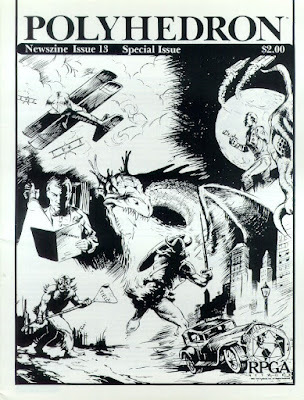James Maliszewski's Blog, page 64
December 18, 2023
The Streets of da-Imer
Last week, I shared part of a larger illustration depicting the Armies of the King-Emperor of da-Imer, as drawn by Zhu Bajiee. I thought I'd follow it up today with part of a tableau depicting some "ordinary" people one might encounter in the streets of the First City.
 On the lefthand edge, there's a spice merchant, her head bowed in deference to the noble lady sampling her wares. The lady belongs to the Arta Char dynasty, an ancient lineage that, unlike many others, welcomed Magdor's accession to the Solar Throne and were rewarded for their support. Next, there's a senior priest of Vulas, goddess of commerce and wealth, offering alms to one of da-Imer's many impoverished youths. Vulas is an imported Chomachto deity whose priests have attempted to curry favor with the Ironian population through ostentatious acts of charity (to limited success). The priest depicted here wears a prayer plaque and carries an unlit candle-staff as badges of his office.
On the lefthand edge, there's a spice merchant, her head bowed in deference to the noble lady sampling her wares. The lady belongs to the Arta Char dynasty, an ancient lineage that, unlike many others, welcomed Magdor's accession to the Solar Throne and were rewarded for their support. Next, there's a senior priest of Vulas, goddess of commerce and wealth, offering alms to one of da-Imer's many impoverished youths. Vulas is an imported Chomachto deity whose priests have attempted to curry favor with the Ironian population through ostentatious acts of charity (to limited success). The priest depicted here wears a prayer plaque and carries an unlit candle-staff as badges of his office.
December 17, 2023
Nativity
 The funny thing about my involvement with Dungeons & Dragons is that it was actually mother who first brought a copy of the game – the Holmes Basic Set – into our house. She bought a copy for my father sometime in August or September 1979, because he'd been talking about D&D a lot. Dad had always been an avid reader and he'd been reading stories about the game in newspapers or magazines. Though I didn't know it at the time, his interest in the game had been sparked by the disappearance of James Dallas Egbert III in August of that year. As my mother explained it to me, she had bought a copy of the boxed set, thinking that Dad would find it interesting. She was mistaken in this, because my father never even opened it. The set, still in its shrink wrap, was then placed in the upstairs linen closet, because that's where lots of items that had no obvious place to put them in our house were frequently stored.
The funny thing about my involvement with Dungeons & Dragons is that it was actually mother who first brought a copy of the game – the Holmes Basic Set – into our house. She bought a copy for my father sometime in August or September 1979, because he'd been talking about D&D a lot. Dad had always been an avid reader and he'd been reading stories about the game in newspapers or magazines. Though I didn't know it at the time, his interest in the game had been sparked by the disappearance of James Dallas Egbert III in August of that year. As my mother explained it to me, she had bought a copy of the boxed set, thinking that Dad would find it interesting. She was mistaken in this, because my father never even opened it. The set, still in its shrink wrap, was then placed in the upstairs linen closet, because that's where lots of items that had no obvious place to put them in our house were frequently stored.And that's where it remained until the Christmas holidays, when my friend Mike received a copy of a boardgame called Dungeon! Back in those days, it was tradition among my friends to spend our Christmas vacation making the rounds at each other's houses, showing off the presents we'd received and pronouncing judgment over which of all the gifts we deemed the best. That year, without question, the winner was
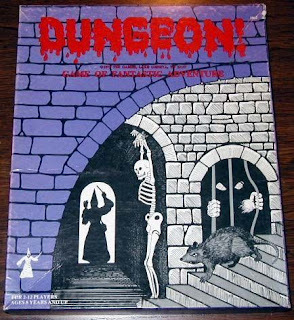 Dungeon! We played it many, many times and we all agreed that Mike was the victor in that year's "competition." What clinched it for us were the monster cards, which included all sorts of bizarre creatures we'd never heard of before, such as a "black pudding." We found the whole thing faintly ridiculous, honestly, but that very ridiculousness also kept us playing and, like some kind of narcotic, we wanted more.
Dungeon! We played it many, many times and we all agreed that Mike was the victor in that year's "competition." What clinched it for us were the monster cards, which included all sorts of bizarre creatures we'd never heard of before, such as a "black pudding." We found the whole thing faintly ridiculous, honestly, but that very ridiculousness also kept us playing and, like some kind of narcotic, we wanted more.That's when I remembered the D&D Basic Set in the linen closet, which I then took out and unwrapped. I gleefully took the rulebook over to Mike's house to show it off and we then attempted to figure out how to play the damned thing. I'm not ashamed to say that we failed utterly in our attempts – not that that stopped us from "playing" Dungeons & Dragons anyway. Our early "adventures" were weird things. We used Dungeon! to "clarify" things we didn't understand in the rulebook and, because my boxed set was one of those that didn't include polyhedral dice, we played using only six-sided dice. I even have a dim recollection of using the board game's playing surface – it wasn't really a board – to run an adventure or two.
Eventually, Mike's older brother, who was a surly teen metal head saw us with the Holmes rule book and listened to our feeble attempts to play the game. He'd never taken much interest in us before, except perhaps to terrorize us with his loud music or to punch Mike when he "got out of line." When he saw us with the D&D book, though, he took some measure of pity on us and tried to help us, in his own
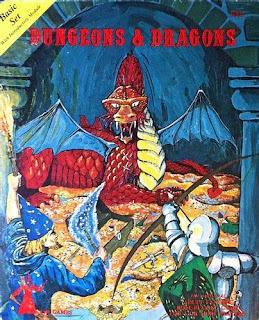 condescending way, to play the game "properly." Of course, Mike's brother didn't play D&D by the book himself; he used lots of house rules and variants and so we adopted them as Gospel truths until we knew better. It was nevertheless a strange turning point for us, because never before had Mike's brother ever treated us so nicely. He still beat up Mike, of course, but a bond, however tenuous, was forged through our mutual love of D&D.
condescending way, to play the game "properly." Of course, Mike's brother didn't play D&D by the book himself; he used lots of house rules and variants and so we adopted them as Gospel truths until we knew better. It was nevertheless a strange turning point for us, because never before had Mike's brother ever treated us so nicely. He still beat up Mike, of course, but a bond, however tenuous, was forged through our mutual love of D&D.I bought the Monster Manual sometime in early 1980, using money I'd received from my grandmother at Christmas. I ordered the book through the Sears catalog and was absolutely captivated – and occasionally frightened – by its contents. I vividly recall the illustration of the Night Hag being particularly unnerving to me. Over the next six months, my friends and I acquired other AD&D books and modules, which we used in conjunction with Holmes – and then Moldvay when it came out the following year – so we probably never played a "pure" version of the game, not that anyone cared. We were having the times of our young lives, creating characters with abandon and inflicting all sorts of monstrous tricks and traps on one another. By popular acclaim, I quickly became
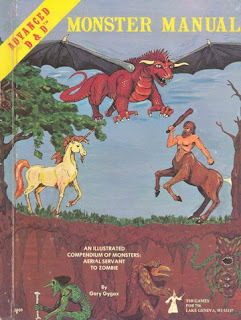
the Dungeon Master. With the rare exceptions of when Mike's brother or father would run us through a dungeon, no one else really took to the role as I did and it's a role I've pretty much had most of my gaming career. I'm not a terrible player, mind you, but my gifts, such as they are, naturally incline me toward refereeing and so it has remained for the better part of the last four decades or so.
Every year, as Christmas rolls around once again, I find myself recalling these events from my childhood. Even today, they're among my fondest memories, because they, quite literally, changed my life forever. There is no way I could have known, in December 1979, that the "weird new game" that my friends and I discovered almost by accident would become the foundation on which I'd build not just a lifelong hobby but also many more friendships. To this day, some of my oldest and dearest friends are those whom I know only because we share a love of roleplaying games. That's why, even though I didn't, strictly speaking, get the D&D Basic Set for Christmas that year, I nevertheless consider it among the best gifts I've ever received.
December 15, 2023
Seeking Alternatives
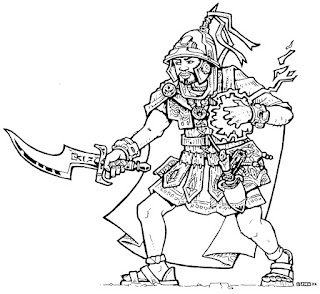 An adventurer by Zhu Bajiee
An adventurer by Zhu BajieeThere are four "basic" human character classes in Secrets of sha-Arthan: the adept, the scion, the sorcerer, and the warrior. There's also a fifth class, which occupies a middle ground between the sorcerer and the warrior – a hybrid fighter/magic-user that I've dubbed the adventurer.
The truth of the matter is that I've never been completely satisfied with the name "adventurer." It's very generic and, more than that, its usage for a specific character class prevents my using it as a broad term for all classes, including the non-human ones. Consequently, I'm forever trying to come up with a better name, one that's actually evocative of what the class is, namely, a fighter/mage.
So, I'm turning to my readership to ask if you have any ideas. What would you call a character class of this sort? A coveted Grognardia No-Prize goes to anyone who comes up with a good alternative.
December 13, 2023
The Armies of the King-Emperor
I'm still working – slowly – on Secrets of sha-Arthan. Right now, I'm in the "chipping away everything that doesn't look like an elephant" stage and, while progress is definitely being made, it's taking much longer than I expected. Some of that is a function of my perfectionism, but some of it also a function of my age. I'm not as given to stretches of manic creativity as I once was. Consequently, I move at a much more languid pace.
Fortunately, Zhu Bajiee has been ably assisting me in this difficult birthing process, providing me with remarkable illustrations that bring my crazy ideas to life, like this one.
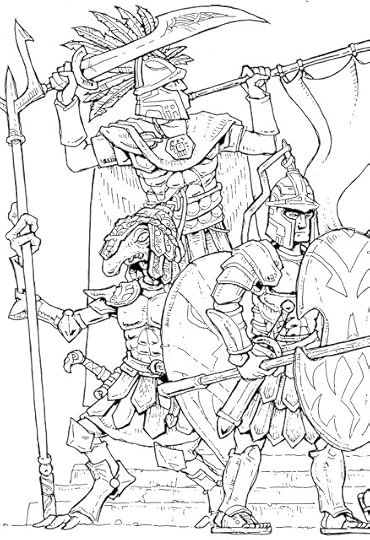 This image is part of a larger one that depicts soldiers in the service of the King-Emperor of Inba Iro. In the back, there's a signal-captain, with his distinctive plumed helmet, ceremonial sword, and teshal (trumpet). Standing in front are two heavy infantrymen. The soldier to the left is a Ga'andrin mercenary from Tlar, clad in a sculpted Ironian-style cuirass, augmented with plates. The soldier to the right is an elite Chomachto halberdier and is attired similarly.
This image is part of a larger one that depicts soldiers in the service of the King-Emperor of Inba Iro. In the back, there's a signal-captain, with his distinctive plumed helmet, ceremonial sword, and teshal (trumpet). Standing in front are two heavy infantrymen. The soldier to the left is a Ga'andrin mercenary from Tlar, clad in a sculpted Ironian-style cuirass, augmented with plates. The soldier to the right is an elite Chomachto halberdier and is attired similarly. I have come to realize that, as with many creative endeavors, there's no real timetable for the completion of Secrets of sha-Arthan. It'll be done when it's done, no matter how many times I think I can accurately predict a conclusion to my work. So long as I continue to enjoy the ride, I can't really complain.
Polyhedron: Issue #14
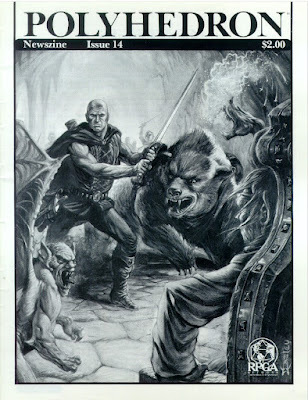 Issue #14 of Polyhedron (October 1983) makes an change to the "Encounters" series begun in issue #8. Originally, the series presented wholly original NPCs created by TSR designers for use with one of the company's many roleplaying games. In this issue (and the next), the featured NPCs are the creations of RPGA members – and are player characters from their home campaigns. The first example of this is member Sonny Scott's PC, Swat, and his cave bear companion, Ox, as described by writer Roger E. Moore and illustrated by Jeff Easley.
Issue #14 of Polyhedron (October 1983) makes an change to the "Encounters" series begun in issue #8. Originally, the series presented wholly original NPCs created by TSR designers for use with one of the company's many roleplaying games. In this issue (and the next), the featured NPCs are the creations of RPGA members – and are player characters from their home campaigns. The first example of this is member Sonny Scott's PC, Swat, and his cave bear companion, Ox, as described by writer Roger E. Moore and illustrated by Jeff Easley.Contrary to the hoary gamer joke, I really would like you to tell me about your character. Hearing about others' characters is often a good way to gain insights into how they're playing the game. That's why I particularly enjoyed the installments of "Encounters" in issues #14 and #15: they gave me a little glimpse into what others were doing with Dungeons & Dragons at their own tables.
The RPGA Network Scholarship announced way back in issue #3 finally has a recipient: a young man by the name of David Lee Griffith from Aurora, Illinois, who was headed to the University of Chicago to study physics. The scholarship is for $1000. I have no idea how much the University of Chicago cost at the time, so it's difficult to say how significant a scholarship this would have been. Still, I find it notable that TSR offered a scholarship at all.
This issue's "Two Cents" column is by Christopher Gandy, who presents "Views on 'Role' Playing." In his one-page essay, he criticizes how little many players actually play their character as different from themselves. As he suggests:
Next time you or your players roll up a set of characteristics, don them like an actor would his wardrobe and portray someone new, someone unique, someone else. Don't just play at a role-playing game, role play during the game.
The extent to which roleplaying is or should be analogous to acting has long been a vexatious topic in RPG circles. Gary Gygax, for example, once famously fulminated against what he called "amateur thespianism," while other luminaries in the hobby held opinions closer to that of Christopher Gandy. As with many such topics, I don't think there's any single correct answer beyond what everyone at the table prefers, but it's good to be reminded that these questions have been with us for decades.
"Dispel Confusion" now takes up four pages, largely because it provides answers to many more questions about the rules of TSR's roleplaying games. Despite their large number, none of the questions in this issue are worthy of comment – which, to be fair, is pretty typical of these kinds of columns (with the exception of "Sage Advice" when Jean Wells was writing it).
"The Lone Wolf" by James M. Ward is a Gamma World article devoted to describing a type of character, whether player or non-player character, who "is perfect for balancing the deadliness of an Ancient installation with the power that can be gotten from looting such a place." The Lone Wolf is thus a very potent character with high ability scores and hit points, as well as a sizable arsenal of high-tech devices. His purpose is as a guide and guardian so that PCs do not "loose [sic] heart" and avoid the dangers of the setting's most lethal ruins. I imagine that Ward wrote it to throw a bone to those GW players who balked at how deadly the game can be and wanted a surer means of protection than "intelligence and role-playing skill."
"D&D Name Means More Than Just Modules" is an article about which I have written before. Since I stand by my original comments on that, I'll move on to Roger E. Moore's "Artifacts, Relics, and DM Headaches." This is a solid, three-page article full of thoughts and advice on introducing artifacts and relics – immensely powerful magic items – into a campaign. It's good stuff, with plenty of ideas to consider, including the fact that the appearance of an artifact or relic is sure to bring its possessor to the attention of others who will undoubtedly want it for themselves. Moore's primary point is that an artifact or relic is not just another magic item. While they certainly can be brought into a campaign to good effect, they can also upset things – and not just "game balance" – to such an extent that the Dungeon Master should think carefully before doing so.
I'm going to pass over two one-page articles about conventions, because they're only of ephemeral interest, especially to me, since I've never been much of a con-goers. Much more significant in my opinion is this small blurb placed at the bottom corner of a page:
 Talk about a blast from the past! I'd completely forgotten about the existence of the Other Worlds Club at Waldenbooks. This really brings back happy memories for me, since I maintained a membership with the club for years and was an avid reader of its newsletter, Xignals.
Talk about a blast from the past! I'd completely forgotten about the existence of the Other Worlds Club at Waldenbooks. This really brings back happy memories for me, since I maintained a membership with the club for years and was an avid reader of its newsletter, Xignals.
"Ambush on Lossend" is a short, mercenary adventure for Star Frontiers , written by Steve Winter. While nothing groundbreaking, I rather like it for its down-to-earth, "gritty" feel, which reminds me more of something GDW would have produced for use with Traveller than what I'd come to expect for Star Frontiers. Finally, there's "Membership Drive Winners," which highlights three RPGA members, Clyde "Sonny" Scott, Randy Solo, and Steve Lierly, who recruited a large number of people to join the association. The top two winners – Scott and Solo – received trips to GenCon, along with various other rewards, including illustrations of their characters (which, in turn, form the basis of the "Encounters" articles in issue #14 and #15).
Issue #14 is definitely a step down from its predecessor, since it didn't have quite as much gameable material in its pages. Still, there's enough here that it held my attention while re-reading it, which is a decent enough gauge of its overall quality.
December 10, 2023
A New Genre Itself
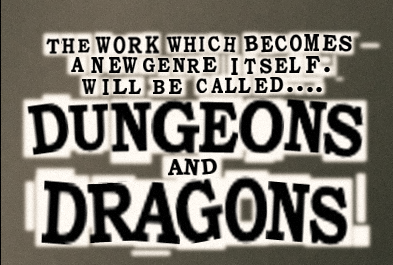 An overriding concern of this blog since its start are the literary precursors of Dungeons & Dragons. Believe it or not, this has often been a somewhat contentious subject, since there's plenty of conflicting evidence on the matter, not to mention a fair bit of obfuscation from the various parties involved. The subsequent history of both D&D and fantasy roleplaying games more generally, including their explosive, faddish popularity in the late '70s and early '80s, has only further muddied the waters, as other creators added their own ingredients to the imaginative chaos that Arneson and Gygax first unleashed upon the world nearly half a century ago.
An overriding concern of this blog since its start are the literary precursors of Dungeons & Dragons. Believe it or not, this has often been a somewhat contentious subject, since there's plenty of conflicting evidence on the matter, not to mention a fair bit of obfuscation from the various parties involved. The subsequent history of both D&D and fantasy roleplaying games more generally, including their explosive, faddish popularity in the late '70s and early '80s, has only further muddied the waters, as other creators added their own ingredients to the imaginative chaos that Arneson and Gygax first unleashed upon the world nearly half a century ago.Even bearing these facts in mind, there can be little doubt, I think, that Gary Gygax at least took his primary inspiration from just a handful of older writers – L. Sprague de Camp, Robert E. Howard, Fritz Leiber, H.P. Lovecraft, Abraham Merritt, Fletcher Pratt, and Jack Vance – and that his conception of the game reflects this. Despite the much-vexed question of Tolkien's influence on the game, I don't think anyone can honestly deny that Gygaxian D&D owes more to what I call "pulp fantasy" than to anything more highfalutin. One need only look at Gygax's various reading lists, culminating in Appendix N of the AD&D Dungeon Masters Guide, to see this.
And yet I'm not sure that matters.
The moment Dungeons & Dragons was released into the wild – or Pandora's Box was opened, to use Greg Stafford's perfect metaphor – it was no longer the possession of any single person, including its creators. This is something Gygax himself recognized early on, even if he had his own ideas about the kind of fantasy roleplaying adventures he most enjoyed. By all accounts, the early days of the hobby were ones of wild, reckless invention, as everyone who got their hands on D&D made it their own. To some extent, this was by necessity, as the original 1974 rules were vague and unclear about just how to interpret them. It was thus an inevitability that a wide variety of mutant strains of Dungeons & Dragons would soon proliferate across the world.
At the same time, many of the game's early adopters liked the idea of D&D, but they took exception to this or that element of it. The changes they introduced to it were made, not out of ignorance of how Arneson and Gygax intended the game to played – assuming there even is such a thing in the first place – but intentionally, in order to bring the game more in line with the kind of fantasy adventures they most enjoyed. Of course, in the process of doing so, they became their own unique games – Tunnels & Trolls, Empire of the Petal Throne, RuneQuest, etc. – which, in turn, spawned their own "mutants," creating an entirely new ecosystem of creativity that continues to this day.
What's most interesting to me right now is that even as Gary Gygax was still in charge of the development of Dungeons & Dragons, or at least AD&D, there was plenty of variation in its presentation and content. Compare the work of David Cook, Lenard Lakofka, Lawrence Schick, and Allen Hammack to that of Gygax – or to each other. Each brings a different perspective and draws on different inspirations to present Dungeons & Dragons as he understands it (and, presumably, prefers it). What's remarkable is that, rather than undermining the game, this approach expands its reach. D&D, even as published by TSR, is a house of many mansions.
This probably explains why D&D was and continues to be the most popular and widely played RPG of all time. Being the first out the door no doubt helped, but I think it's more than that. D&D has always been a loose, reasonably flexible framework to which one can add (or subtract) whatever one requires for one's preferred style of fantasy adventures. Gygax unquestionably had his own preferences, but so too did everyone who's ever written for or played the game over the last fifty years. There is no reason that your D&D and my D&D should be the same, or even similar. Indeed, I remember a time when it was commonplace to assume every campaign was as unique as its players and referee, which is as it should be, in my opinion.
Dungeons & Dragons is a very strange game. It's one whose play can vary considerably from place to place, yet which is nevertheless completely recognizable to anyone who's even passingly familiar with the form of that play. I won't go so far as to say that no other RPG is similar in this regard, but D&D exemplifies this to a much greater extent than any other roleplaying game of which I can think. It's one of the most amazing things about D&D and I don't think it gets enough credit for it.
December 5, 2023
Polyhedron: Issue #13
Issue #13 of Polyhedron (August 13) is dubbed a "special issue," because, in the words of its editor, Mary Kirchoff, more "strictly gaming aid articles." What that means is that, unlike previous issues, this one includes no RPGA ephemera, only articles for use with TSR's various roleplaying games. This is precisely what I'd hoped to see in the pages of Polyhedron when I first started to subscribe to it. Alas, the 'zine would return to its earlier form with issue #14, but I nevertheless enjoyed this one, singular though it was.
The letters page contains two letters of note. One asks about the possibility of a D&D movie, while the other questions why Deities & Demigods includes "fighting abilities and statistics" for the gods described therein. Here's the response regarding a D&D movie:
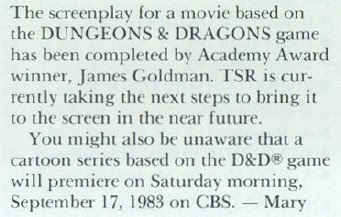 The story of the D&D movie Gary Gygax was supposedly working on during his time in Hollywood is the stuff of legend. I know very little about it myself, but Jon Peterson, has written a lengthy essay about its history and development that's well worth your time.
The story of the D&D movie Gary Gygax was supposedly working on during his time in Hollywood is the stuff of legend. I know very little about it myself, but Jon Peterson, has written a lengthy essay about its history and development that's well worth your time. The Deities & Demigods question is interesting, both for the answer (provided by DDG co-author James M. Ward) and for its asker, a name that might be recognizable to those familiar with the luminaries of the OSR:
 And here is Ward's answer:
And here is Ward's answer: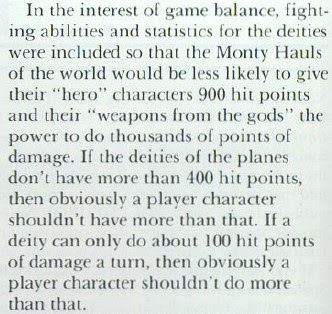 This is pretty much the same logic employed by Tim Kask in the foreword to Gods, Demigods & Heroes, the predecessor to the DDG. I'm not entirely sure what to make of it, except that it suggests TSR felt a need to police the boundaries of power within D&D. What an odd thing!
This is pretty much the same logic employed by Tim Kask in the foreword to Gods, Demigods & Heroes, the predecessor to the DDG. I'm not entirely sure what to make of it, except that it suggests TSR felt a need to police the boundaries of power within D&D. What an odd thing!"Dispel Confusion" contains the usual assortment of questions about TSR's stable of roleplaying games. Of these, one stands out as worthy of being highlighted:
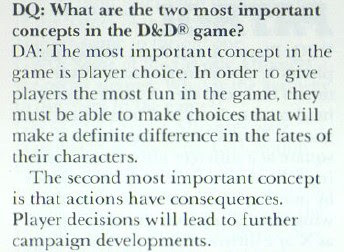 One can quibble about whether these are indeed "the two most important concepts in the D&D game," but I find it difficult to disagree that both of these concepts in the answer are indeed significant ones, particularly the second one. My ongoing House of Worms campaign – which will celebrate its ninth year of continuous play in March 2024 – is largely propelled by player choice and the consequences of those choices, for example.
One can quibble about whether these are indeed "the two most important concepts in the D&D game," but I find it difficult to disagree that both of these concepts in the answer are indeed significant ones, particularly the second one. My ongoing House of Worms campaign – which will celebrate its ninth year of continuous play in March 2024 – is largely propelled by player choice and the consequences of those choices, for example.Mary Kirchoff provides another installment of "Under Construction," this one being something of a follow-up to the one that appeared in issue #10. Like its predecessor, it's clever and flavorful – a good example of a dungeon "special." The issue also includes a "policy statement" from the publishing division of TSR, regarding Dragon and the newly-acquired Ares :
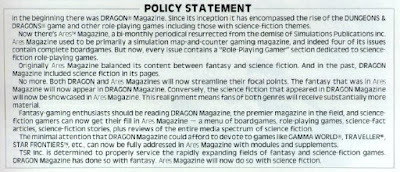 In short, TSR decided to focus Dragon solely on fantasy RPGs, shifting science fiction RPGs over to Ares. This was a huge disappointment to me at the time, because then, as now, I prefer SF to fantasy and I had no interest in subscribing to yet another gaming magazine. Ultimately, like everything else TSR did with the former SPI's properties, this move was ill-considered and failed. In time, Ares would cease to exist as a stand-alone magazine and sci-fi content would be re-incorporated into Dragon in the form of the Ares Section, which would become one of my favorite parts of the magazine.
In short, TSR decided to focus Dragon solely on fantasy RPGs, shifting science fiction RPGs over to Ares. This was a huge disappointment to me at the time, because then, as now, I prefer SF to fantasy and I had no interest in subscribing to yet another gaming magazine. Ultimately, like everything else TSR did with the former SPI's properties, this move was ill-considered and failed. In time, Ares would cease to exist as a stand-alone magazine and sci-fi content would be re-incorporated into Dragon in the form of the Ares Section, which would become one of my favorite parts of the magazine.Roger E. Moore's "Gods, Demigods, and DMs" is yet another look at the apparently vexed question of how to handle interactions between deities and powerful player characters. Moore's advice is generally very good, relying on both mythological tales, the AD&D rules, and common sense as guides. He quite reasonably believes that the gods should not be seen as "pushovers" even by the mightiest PCs and that the DM should pull out all the stops when roleplaying gods and demigods that their awesomeness is fully manifest. As I said, he provides lots of solid advice and examples, but I still have to wonder: were battles with the gods so commonplace that TSR needed to address it again and again?
"Spelling Bee" by James M. Ward looks at just two spells: continual light and its reverse, continual darkness, in order to show how versatile and useful they can be in play. I appreciate articles like this, because I've long felt that (A)D&D has too many spells, especially when one considers how many ways even a handful of spells can be used by a clever caster. Pointing out all the ways existing spells might be employed goes some way, I think, toward alleviating the need for further, ever more specific, spells – at least that's my feeling.
"The Hive Master" by Harold Johnson is an unusual four-page adventure for use with Gangbusters. I say "unusual," because, unlike all previous scenarios written for the game, this one doesn't deal with bootlegging or bank robbery but instead with efforts by a mad scientist – Professor Abe Malefica – to get his revenge on the world who mocked him by releasing a specially-bred type of harvester bee into the world. It's pulp nonsense of the highest order and I hated it at the time. Looking at it now, though, I have a better appreciation for what Johnson was doing, even if he refers to Malefica as an "entymologist."
The issue includes a double-sided cardstock reference sheet of Dawn Patrol rules and tables. I still have mine inside my game box to this day. "Ecosystem," another by Ward, looks at the ramifications of the environment in Gamma World on adventure scenarios. "Go West, Young Gamer" by Steve Winter suggests the inclusion of four new ability scores to Boot Hill – Coordination, Observation, Stature, and Luck – as a way to further differentiate characters in the game. Given that BH is a very primitive game in terms of mechanics, this makes some sense. Does anyone know if these were these incorporated into the third edition of the game by chance?
"Raid on Theseus" by Doug Niles is a starship combat scenario for use with Knight Hawks. Kim Mohan's "Psionic Pspells" is a lengthy (four pages) article looking at "spells resembling psionic powers" from every possible angle. These spells are enumerated in Appendix C of the AD&D Dungeon Masters Guide, but Mohan is, for some reason, interested in explaining the logic behind each spell's inclusion in the list in order to better understand AD&D magic, psionics, and the interplay of the two. I cannot say I share his enthusiasm for the topic. "The Condor Assignment" by Allen Hammack is ostensibly a Top Secret article, but it's mostly a review of then-current espionage media, like the Bond novel, Icebreaker.
Other than the obligatory RPGA catalog at the end, that's issue #13. Though no longer than its immediate predecessors, it certainly feels meatier to me, probably because of the lack of RPGA ephemera that didn't interest me at the time and interests me even less four decades later. This issue represents what I always wanted Polyhedron to be, but very rarely got – a pity.
December 4, 2023
"Played by friends, not strangers"
In light of several discussions over the last few weeks, especially the matter of evil characters, I thought this paragraph from an early review of Dungeons & Dragons (Campaign magazine issue 81 – September/October 1977) might be of interest.
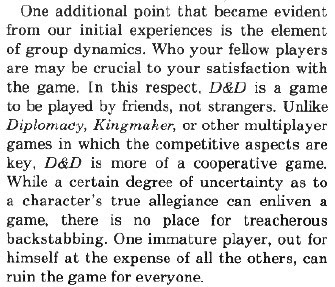 While I take some issue with the idea that D&D (and RPGs more generally) can't be competitive – but that's probably a topic for a different time – I do very much agree with the idea that it's best played with friends rather than with strangers. In fact, I'd go so far as to say that most of the supposed "problems" some have found in this RPG or that one ultimately stem not from the games themselves but from the people with whom the critics have chosen to play.
While I take some issue with the idea that D&D (and RPGs more generally) can't be competitive – but that's probably a topic for a different time – I do very much agree with the idea that it's best played with friends rather than with strangers. In fact, I'd go so far as to say that most of the supposed "problems" some have found in this RPG or that one ultimately stem not from the games themselves but from the people with whom the critics have chosen to play. "Who your fellow players are may be crucial to the your satisfaction with the game." No truer words have ever been written about roleplaying games.
A Fuzzy Fairyland
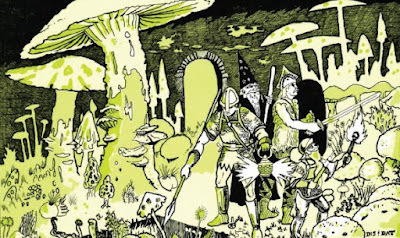 When I was re-reading
In Search of the Unknown
over the weekend in preparation for my earlier post today, I came across this passage, describing the Garden Room:
When I was re-reading
In Search of the Unknown
over the weekend in preparation for my earlier post today, I came across this passage, describing the Garden Room:The floor is covered with a carpet of tufted molds that extends to all the walls and even onto parts of the ceiling, obscuring the rock surface. The molds appear in a rainbow assortment of colors, and they are mixed in their appearance, with splotches, clumps, swirls, and patches presenting a nightmarish combination of clashing colors. This is indeed a fuzzy fairyland of the most forbidding sort, although beautiful in its own mysterious way ...
A common characteristic of fans of old school gaming is their preference for concise, even spartan, prose in the descriptions of adventure locales. While I broadly share this preference – my feelings about lengthy, overwrought descriptions are well known – I nevertheless do think there ought to be room for evocative, inspiring writing in RPG scenarios. Consider Gary Gygax's description of Erelhei-Cinlu in Vault of the Drow (which is interesting, because it also makes use of the word "fairyland"), which I think is a good example of what I'm talking about.
Are there any passages from an RPG adventure that you find evocative and inspiring?
December 3, 2023
Mystifying and Dangerous
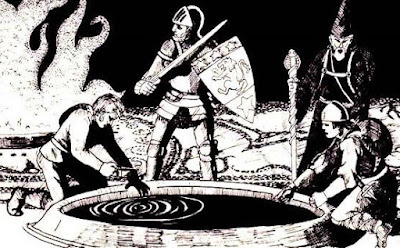 As any regular reader of this blog already knows, the very first D&D module I ever owned was In Search of the Unknown. One of the consequences of this is that, for good and for ill, it very soon became my mental model for what a dungeon should be like. More specifically, module B1 instilled in me an early love of tricks, traps, and secrets as integral elements of a dungeon. Nearly every room is Quasqueton contains one of these elements, whether they take the form of a forest of weird fungi, a set of false stairs, or the famous room of pools.
As any regular reader of this blog already knows, the very first D&D module I ever owned was In Search of the Unknown. One of the consequences of this is that, for good and for ill, it very soon became my mental model for what a dungeon should be like. More specifically, module B1 instilled in me an early love of tricks, traps, and secrets as integral elements of a dungeon. Nearly every room is Quasqueton contains one of these elements, whether they take the form of a forest of weird fungi, a set of false stairs, or the famous room of pools. The most important thing for me, then and now, is that the dungeon includes lots of things for the characters – and their players – to fiddle with and puzzle over. That's one of the great appeals of dungeon delving: trying to figure it out. Of course, it helps immensely when figuring things out brings with it a tangible benefit, like treasure or knowledge. There needs to be some kind of incentive to making the extra effort, just as there needs to be some kind of risk to balance it.
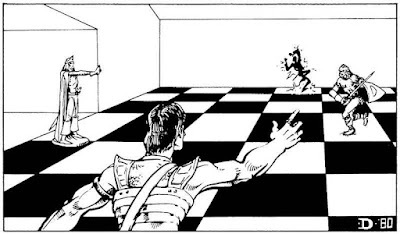 Volume 3 of Original Dungeons & Dragons contains the earliest advice to the referee in designing a dungeon. One of the most memorable bits of that advice is the following:
Volume 3 of Original Dungeons & Dragons contains the earliest advice to the referee in designing a dungeon. One of the most memorable bits of that advice is the following:The fear of "death", its risk each time, is one of the most stimulating parts of the game. It therefore behooves the campaign referee to include as many mystifying and dangerous areas as is consistent with a reasonable chance of survival (remembering that the monster population already threatens this survival).That comes very close to encapsulating the lessons I drew from reading In Search of the Unknown all those years ago. If you look at many of the earliest published dungeons, whether from TSR, Judges Guild, or appearing in the pages of Dragon and other RPG periodicals, you'll see they almost always include enigmas, puzzles, and traps of varying degrees of fiendishness. Indeed, I'd go so far as to suggest that these elements are integral to what a dungeon is.
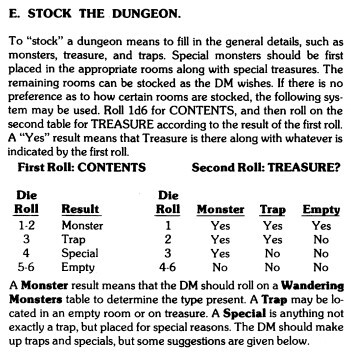 Tom Moldvay's 1981 revision of the D&D Basic Set provides step-by-step instructions to the novice referee on how to create and stock a dungeon. If one follows those steps faithfully, approximately one-third of all dungeon rooms will contain either a trap or a "special," Moldvay's version of OD&D's "tricks." Specials aren't necessarily dangerous, but they're definitely odd and unusual. Moldvay gives several examples of specials, ranging from a "moaning room or corridor" to a "talking statue" to a "shifting block to close off corridor."
Tom Moldvay's 1981 revision of the D&D Basic Set provides step-by-step instructions to the novice referee on how to create and stock a dungeon. If one follows those steps faithfully, approximately one-third of all dungeon rooms will contain either a trap or a "special," Moldvay's version of OD&D's "tricks." Specials aren't necessarily dangerous, but they're definitely odd and unusual. Moldvay gives several examples of specials, ranging from a "moaning room or corridor" to a "talking statue" to a "shifting block to close off corridor." I adore these kinds of dungeon elements. Anything that gets the players thinking about the dungeon, even simply as a play space, greatly appeals to my sensibilities. Old school D&D fans often say that the hobby was born in the megadungeon and, while there's much truth to that, I think it's just as true to say that the hobby was born in the challenge dungeon, which is to say, a space where the players matched wits against the referee in figuring out his puzzles and overcoming the trials he set before them. My appreciation for this style of play may explain why I've never hated The Tomb of Horrors as so many others have.
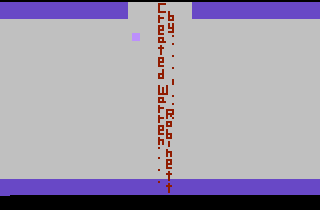 Over the years, I get the impression that tricks, traps, and secrets of this sort have become a lot less popular among players of Dungeons & Dragons, but perhaps that's mistaken. What I can say with some certainty is that, fairly early on in their existence, video games, especially since the advent of the personal computer, have taken up the idea of trials and secrets in a way that I find very reminiscent of early D&D challenge dungeons. That shouldn't come as a surprise, of course, since D&D's influence on the development of video games – and not just of the RPG genre – is immense.
Over the years, I get the impression that tricks, traps, and secrets of this sort have become a lot less popular among players of Dungeons & Dragons, but perhaps that's mistaken. What I can say with some certainty is that, fairly early on in their existence, video games, especially since the advent of the personal computer, have taken up the idea of trials and secrets in a way that I find very reminiscent of early D&D challenge dungeons. That shouldn't come as a surprise, of course, since D&D's influence on the development of video games – and not just of the RPG genre – is immense. Still, I can't help but feel that dungeons are at their most fun for me when they include lots of riddle-spouting statues, giant chessboards, green devil faces, and deviously hidden secret rooms. A dungeon without such things will soon get boring and will never become a campaign tent pole of the sort that encourages return visits. I can't tell you how many hours I've poured into certain video games over the years trying to beat exceedingly difficult encounters or trying to locate some hidden chamber, often for very little in-game reward. There's no reason dungeons can't be like that, too.
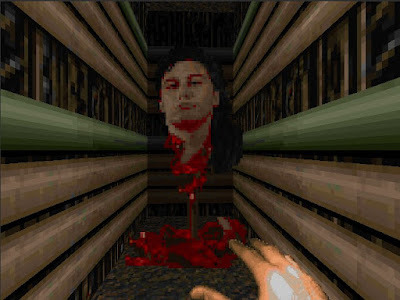
James Maliszewski's Blog
- James Maliszewski's profile
- 3 followers


